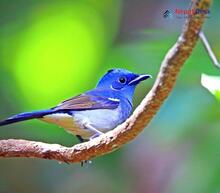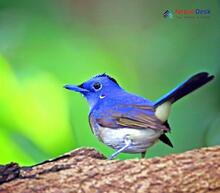The Hypothymis genus, with its captivating profile, is a remarkable group of bird species native to Nepal. These striking birds boast striking features that attract birdwatchers and nature lovers alike. Let's delve into the enchanting world of the Hypothymis genus and explore their distinct characteristics and the vital role they play in Nepal's diverse ecosystem.
Discovering the Hypothymis Genus
Belonging to the family Monarchidae, the Hypothymis genus comprises small passerine birds predominant in Asia's tropical regions, including the breathtaking landscapes of Nepal. These elegant birds are characterized by their sleek profiles, which include a prominently crested head and an elongated tail. Two notable species under this genus are the Black-naped Monarch (Hypothymis azurea) and the Short-crested Monarch (Hypothymis helenae).
The Allure of Black-naped Monarch
The Black-naped Monarch, known for their eye-catching blue plumage with contrasting black markings, is a familiar sight in Nepal's lush forests. Males exhibit more vibrant colors than females, boasting a lustrous blue hue with a prominent black nape on their crest. In contrast, females have a duller blue shade with white undersides. This sexually dimorphic characteristic allows for easy identification between the genders.
Habitat and Behavior
Nepal's dense forests and well-preserved habitats serve as ideal breeding grounds for the Hypothymis genus. Preferring the dense canopy of evergreen forests, these agile birds forage for insects by skillfully navigating through foliage and branches.
The nesting behavior of the Hypothymis genus is unique. They build their nests using twigs and plant fibers to create a cup-like structure suspended from tree branches. During the breeding season, these birds practice monogamy, with both parents taking turns incubating eggs and feeding their young.
The Significance of the Hypothymis Genus in Nepal
The Hypothymis genus is an essential part of Nepal's thriving ecosystem. These insectivorous birds contribute to maintaining a balanced environment by controlling insect populations. In addition, the striking appearance and behavior of these birds help boost ecotourism, drawing birdwatchers and nature enthusiasts to Nepal seeking a glimpse of these elusive beauties.
Conservation Efforts
To ensure the survival of the Hypothymis genus and other native species, integrating conservation efforts into existing ecotourism projects in Nepal is crucial. These initiatives include habitat preservation, implementing responsible tourism guidelines, and creating awareness among local communities about the importance of preserving these unique bird species.
In conclusion, the Hypothymis genus contributes significantly to the rich biodiversity found in Nepal. As we continue to appreciate and understand these remarkable birds' fascinating profiles and behaviors, it becomes even more imperative to support conservation efforts in maintaining a balanced ecosystem and promoting sustainable ecotourism for future generations.


